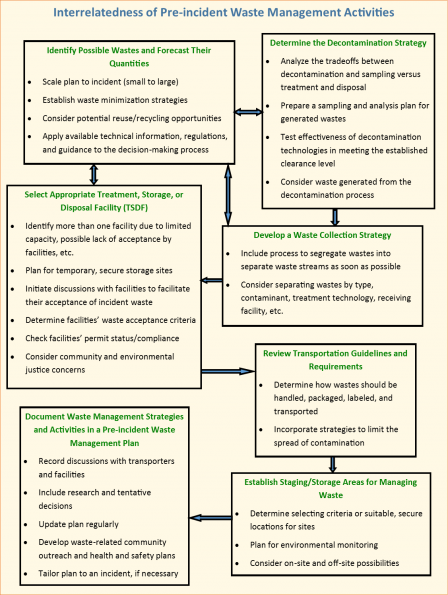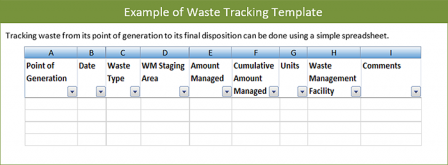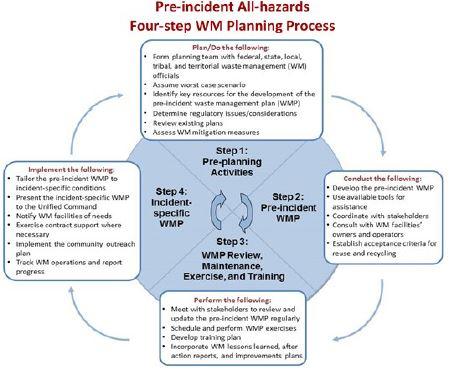Waste Management Benefits, Planning and Mitigation Activities for Homeland Security Incidents
The primary goal of pre-incident waste management planning is to prepare a community to effectively manage waste, debris and materials generated by a homeland security incident, including reducing the potential amount of waste generated at the outset. Communities can follow EPA’s comprehensive Pre-incident All-Hazards Four Step Waste Management (WM) Planning Process or, if resources and time are limited, focus on one or more pre-incident planning activity at a time.
- Benefits of Pre-incident Waste Management Planning
- Planning with Limited Time and Resources
- Interrelatedness of Pre-incident Waste Management Activities
- Pre-incident All-Hazards Four Step Waste Management (WM) Planning Process
Benefits of Pre-incident Waste Management Planning
Nearly all incidents generate waste, debris and materials. While the amount of waste varies between incidents, the generated waste is often greater than the amount of waste many communities handle each year. Additionally, homeland security incidents may generate waste streams, such as chemical, biological and radiological-contaminated wastes, which typically are not handled by communities or waste management facilities. In addition to helping the whole community prepare for these potential wastes, pre-incident planning encompasses source reduction and hazard mitigation activities aimed at reducing the total amount of waste generated by an incident, especially for a large-scale natural disaster. While this pre-incident planning should be documented in a Waste Management Plan (WMP), the community’s preparation provides the most benefits, such as:
- Saves valuable time and resources during an incident
- Allows more efficient and effective waste management decision-making during an incident
- Encourages stakeholders (e.g., state, local, tribal and territorial governments; owners of private storage, treatment and disposal facilities; residents) to work together before an incident occurs
- Boosts the community’s resiliency, resulting in a quicker and less costly recovery to its pre-incident state
- Enhances communities’ adaptation to the waste-related impacts of climate change
- Minimally detracts from, or otherwise impacts, the broader response and recovery efforts due to the efficient implementation of waste management activities
Planning with Limited Time and Resources
Pre-incident planning can be done in stages. Below is a list of waste management planning activities that may provide the greatest benefit for a community that has limited resources and time to devote to planning. Small but significant steps taken prior to an incident can have a big impact on the efficiency and effectiveness of post-incident waste management decision-making.
For example, few facilities are able to accept radiological-contaminated waste. Knowing where radiological-contaminated waste can be takenExitand if it will be accepted by the facility before a radiological incident occurs means that the site can be cleaned up faster (e.g., contaminated waste immediately can begin to be transported off-site to a permitted facility), limiting the possible spread of contamination (e.g., minimizes opportunities for radiation to spread into the surrounding environment due to weather and other factors). Even if a radiological incident is unlikely to occur in a particular community, planning for radiological contaminated waste has value beyond radiological incidents. For example, a large-scale natural disaster may damage hospitals and generate mixed waste (i.e., waste containing both radioactive and hazardous waste components) that would need to be managed at an appropriate facility. Further ideas on planning activities can be found in the Pre-incident All-Hazards Four Step Waste Management (WM) Planning Process section.
- Consult with interested stakeholders
- Which people in your community have information or resources related to various waste management-related activities? (e.g., transportation, sanitation, emergency response, environmental health, public health, public works, zoning, key industry and business leaders)
- What is each stakeholder’s role and/or authority to act during an incident? (e.g., issue emergency declarations, issue permit waivers)
- Identify potential waste streams
- What are the possible waste streams that an incident may generate in your community, considering the industrial, agricultural, residential and commercial aspects of the community?
- Do any federal or local laws or regulations apply to the potential waste streams?
- How much waste is expected to be generated by each waste streamExit, in relative terms?
- Can the amount of potentially generated waste be reduced by means of source reduction (e.g., updating building codes for resilient building design and construction) or hazard mitigation (e.g., eliminating potential problematic wastes, such as retrofitting PCB transformers to reduce PCB-contaminated wastes) activities?
- Evaluate the reuse and recycling program
- What reuse and recycling options (e.g., recycling facilities, end markets for reused and recycled products) currently are available to your community within and/or across jurisdictional lines?
- Can the existing reuse and recycling program be scaled up to handle disaster-related wastes?
- Does your community have green building programs, local waste management ordinances and/or building code requirements that encourage the creation and help maintain a robust reuse and recycling infrastructure?
- Consider waste collection strategies
- How may the waste be separated into different waste streams before being removed from the site of the incident?
- Can the volume of the waste be reduced?
- How may the waste be collected and transported off-site after an incident?
- Determine locations or criteria for waste management sites
- What locations are suitable for waste staging, storage and decontamination activities?
- Are contracts pre-negotiated for those sites?
- What criteria should be used for selecting appropriate sites for different waste streams, if locations cannot be pre-determined?
- Select potential waste management facilities
- What reuse, composting, recycling, treatment and disposal options currently are available in your community, state or region (see the Disaster Debris Recovery Tool and I-WASTE Exit)?
- Which waste streams may each waste management facility accept?
- How much of each waste stream can each facility receive?
- Under what conditions, if at all, will specific facilities accept the waste?
- Are contracts pre-negotiated with these facilities, as well as with neighboring communities?
- Create a waste management-focused community outreach plan
- How may your community be informed of waste management-related information, including the transportation and management of incident-related wastes in or near the community?
- What are the most effective methods of notifying your community about the risks that each waste stream may present to human health and the environment?
- Which people or groups in your community can help you spread important information?
- What are possible ways to increase public understanding and acceptance of decontaminated wastes, reused materials and recycled products made from incident-related wastes?
- Address health and safety considerations for waste management operations
- What are the risks associated with the potential waste streams and the use of decontamination technologies?
- Do emergency personnel have appropriate training regarding waste handling and management?
- Is personal protective equipment (PPE) available should an incident occur?
Interrelatedness of Pre-incident Waste Management Activities
 Click image to view larger version.
Click image to view larger version.
Pre-incident All-Hazards Waste Management Planning Process
EPA’s pre-incident waste management planning process is designed to help communities prepare for an incident’s waste management needs, regardless of the hazard. This recommended process guides emergency managers and planners through four steps that cover the initiation, creation, updating and implementation of a waste management plan. The waste management planning process does not have to be completed at one time or by one person.
- Step 1: Conduct Pre-planning Activities
- Prioritize plan development
- Conduct a community-specific hazard assessment that looks at realistic worst-case scenarios and hazards, their likelihood, and the potential volumes and masses of wastes generated.
- Consider whether you want a single plan that addresses all hazards (recommended)1 or separate, scenario-specific plans.
- Identify and engage with individuals and groups who should be involved in the planning process, as appropriate
- Consult individuals or groups who represent transportation, sanitation, emergency response, environmental health, public health, public works, zoning, agriculture, industry and business among others.
- Identify, review, and coordinate national, regional, state, local, tribal, territorial and any organization-specific plans and mutual aid agreements
- Include plans of bordering jurisdictions, including bordering states, countries and tribal lands if applicable.
- Enhance community resiliency by identifying opportunities for source reduction (e.g., updating building codes for resilient building design and construction), hazard mitigation (e.g., eliminating potential problematic wastes), and developing infrastructure for composting, recycling and reuse of materials.
- Determine legal and regulatory waste management requirements, issues, and considerations
- Review the Federal Emergency Management Agency’s (FEMA’s) eligibility requirements, specifically those pertaining to debris removal, for applicable situations, such as a federal emergency or major disaster declaration2
- Identify unique local circumstances and issues that may affect waste management during an incident (e.g., union concerns, geography, environmental justice concerns)
1 This document assumes a single, comprehensive WMP that covers all hazards will be developed; however, separate scenario-specific plans would address much of the same information but would be tailored to the specific scenario.
2 Emergency managers and planners may find more detailed information regarding pre-incident planning activities in EPA’s Planning for Natural Disaster Debris document and FEMA’s Public Assistance Program and Policy Guide. - Prioritize plan development
- Step 2: Develop a Comprehensive Pre-incident Waste Management Plan (WMP)
- Use available tools to aid in plan development
-
EPA’s Pre-incident All Hazards Waste Management Plan Guidelines: Four Step Waste Management Planning Process provides a suggested outline for a scalable, adaptable pre-incident plan that includes recommended plan contents and identifies issues to consider while developing the plan. The specific contents and organization of a WMP are flexible. This document provides a general example to help emergency managers and planners get started.1
-
- Consult the individuals identified in Step 1 when developing the plan
- Consult haulers, owners and operators of waste management facilities, including reuse and recycling facilities, and other entities as they are identified while developing the plan
- For unique waste streams, specialized expertise may be needed for transport and other waste management activities. Make sure all entities receive a copy of the relevant portions of the plan when it is completed.
- Identify options for reuse, recycling, and composting for different materials and wastes
- Consult with facilities and appropriate regulatory authorities about establishing acceptance criteria for these materials and wastes.
1 For additional assistance in preparing a waste management plan, see “Appendix D: Debris Management Plan Job Aid” in FEMA’s Public Assistance Program and Policy Guide and FEMA’s Independent Study Course, “IS-633: Debris Management Plan Development,” which is available online through the Emergency Management Institute.
- Use available tools to aid in plan development
- Step 3: Keep the Waste Management Plan (WMP) Updated
- Reach out to stakeholders across the whole community to review and update the pre-incident WMP regularly
- Schedule waste management-related exercises and track the schedule, scenarios exercised and stakeholders involved
- Develop a training plan to address training needs for staff and equipment (e.g., National Incident Management System (NIMS), National Response Framework (NRF), technical, and health and safety trainings)
- Incorporate any waste management lessons learned, after action reports and improvement plans into the pre-incident WMP
- Reach out to stakeholders across the whole community to review and update the pre-incident WMP regularly
- Step 4: Implement the Waste Management Plan (WMP) During an Incident
- Identify the pre-incident WMP that best aligns with the specific incident, if applicable
- Identify waste management-related policy or implementation issues that require resolution
- Create the incident-specific WMP based on the pre-incident WMP
- Include the incident’s situational overview, generated waste types and quantities, locations of waste, an exit strategy and health and safety requirements, and update other sections of the incident-specific plan with real-world numbers.
- Present the incident-specific plan to the appropriate Incident Command staff (response to an incident, including waste management decision-making, will occur within the Incident Command System)
- Notify waste management facilities of anticipated needs and utilize contract support where necessary
- Implement the waste management-related community communications and outreach plan in line with the broader, overall incident communications plan
- Identify waste sampling requirements and notify labs of anticipated analysis needs
- Conduct waste management oversight activities, such as site visits to, inspections of, and environmental monitoring at waste management sites as appropriate
- Implement a comprehensive waste and material tracking and reporting system

- Ensure protection of human health and the environment at the incident site over the long-term through continued environmental monitoring, cleanup, inspections, and other activities as necessary
- Identify the pre-incident WMP that best aligns with the specific incident, if applicable

